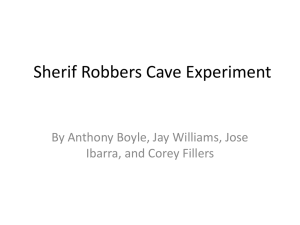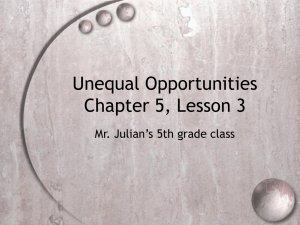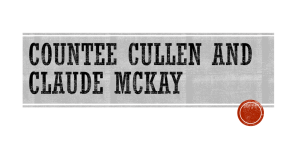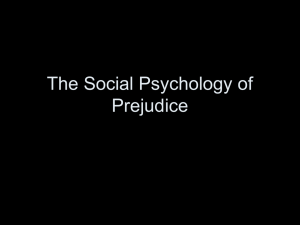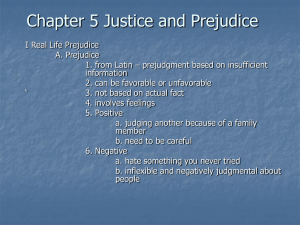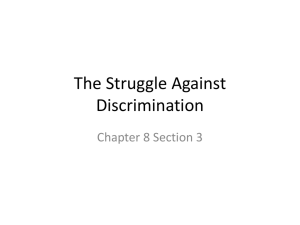Grade 11 ELA Module 2, Unit 1, Lesson 12
advertisement
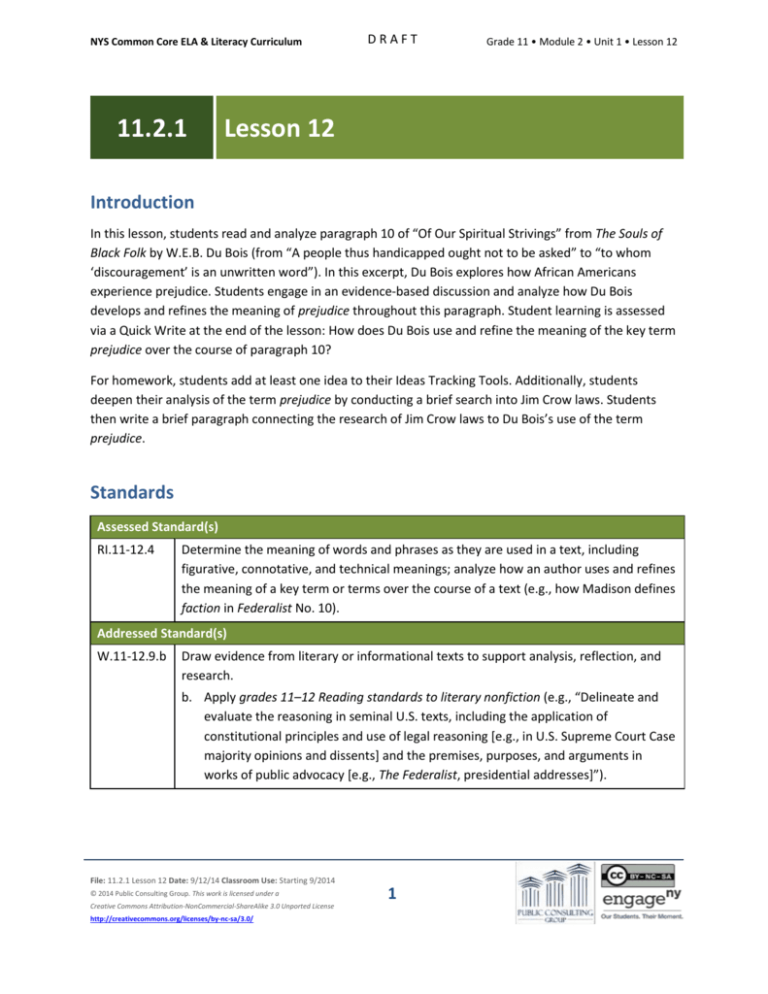
NYS Common Core ELA & Literacy Curriculum 11.2.1 DRAFT Grade 11 • Module 2 • Unit 1 • Lesson 12 Lesson 12 Introduction In this lesson, students read and analyze paragraph 10 of “Of Our Spiritual Strivings” from The Souls of Black Folk by W.E.B. Du Bois (from “A people thus handicapped ought not to be asked” to “to whom ‘discouragement’ is an unwritten word”). In this excerpt, Du Bois explores how African Americans experience prejudice. Students engage in an evidence-based discussion and analyze how Du Bois develops and refines the meaning of prejudice throughout this paragraph. Student learning is assessed via a Quick Write at the end of the lesson: How does Du Bois use and refine the meaning of the key term prejudice over the course of paragraph 10? For homework, students add at least one idea to their Ideas Tracking Tools. Additionally, students deepen their analysis of the term prejudice by conducting a brief search into Jim Crow laws. Students then write a brief paragraph connecting the research of Jim Crow laws to Du Bois’s use of the term prejudice. Standards Assessed Standard(s) RI.11-12.4 Determine the meaning of words and phrases as they are used in a text, including figurative, connotative, and technical meanings; analyze how an author uses and refines the meaning of a key term or terms over the course of a text (e.g., how Madison defines faction in Federalist No. 10). Addressed Standard(s) W.11-12.9.b Draw evidence from literary or informational texts to support analysis, reflection, and research. b. Apply grades 11–12 Reading standards to literary nonfiction (e.g., “Delineate and evaluate the reasoning in seminal U.S. texts, including the application of constitutional principles and use of legal reasoning [e.g., in U.S. Supreme Court Case majority opinions and dissents] and the premises, purposes, and arguments in works of public advocacy [e.g., The Federalist, presidential addresses]”). File: 11.2.1 Lesson 12 Date: 9/12/14 Classroom Use: Starting 9/2014 © 2014 Public Consulting Group. This work is licensed under a Creative Commons Attribution-NonCommercial-ShareAlike 3.0 Unported License http://creativecommons.org/licenses/by-nc-sa/3.0/ 1 NYS Common Core ELA & Literacy Curriculum DRAFT Grade 11 • Module 2 • Unit 1 • Lesson 12 Assessment Assessment(s) Student learning is assessed via a Quick Write at the end of the lesson. Students respond to the following prompt, citing textual evidence to support analysis and inferences drawn from the text. How does Du Bois use and refine the meaning of the key term prejudice over the course of paragraph 10? High Performance Response(s) A High Performance Response should: Explain how Du Bois uses the term prejudice over the course of paragraph 10 (e.g., Du Bois first gives white Americans’ explanation of prejudice “as the natural defence of culture against barbarism” (par. 10). Then Du Bois contrasts this explanation with African Americans’ experience of prejudice as “personal disrespect and mockery” (par. 10).). Explain how Du Bois refines the term prejudice over the course of paragraph 10 (e.g., By contrasting white Americans’ explanation with African Americans’ experience, Du Bois refines the meaning of the term prejudice to demonstrate that although white Americans think of “prejudice” (par. 10) as necessary and good because it defends culture, it is a harmful force that “systematic[ally] humiliat[es]” (par. 10) and undermines the African American community.). Vocabulary Vocabulary to provide directly (will not include extended instruction) homage (n.) – respect or reverence paid or exhibited or showed obeisance (n.) – a movement of the body expressing deep respect or deferential courtesy, as before a superior; a bow, curtsy, or other similar gesture wanton (adj.) – without regard for what is right, just, humane, etc.; careless, reckless cynical (adj.) – bitter or sneeringly distrustful, contemptuous, or pessimistic inculcate (v.) – to cause (something) to be learned by (someone) by repeating it again and again disdain (n.) – a feeling of contempt for anything regarded as unworthy Vocabulary to teach (may include direct word work and/or questions) barbarism (n.) – an uncivilized state or condition just (adj.) – fair File: 11.2.1 Lesson 12 Date: 9/12/14 Classroom Use: Starting 9/2014 © 2014 Public Consulting Group. This work is licensed under a Creative Commons Attribution-NonCommercial-ShareAlike 3.0 Unported License http://creativecommons.org/licenses/by-nc-sa/3.0/ 2 NYS Common Core ELA & Literacy Curriculum DRAFT Grade 11 • Module 2 • Unit 1 • Lesson 12 Additional vocabulary to support English Language Learners (to provide directly) ought (modal v.) – used to say or suggest what should be done gleefully (adv.) – acting in a way full of a strong feeling of happiness or great pleasure or satisfaction meekly (adv.) – acting in a quiet and gentle way well-nigh (adv.) – almost or nearly boisterous (adj.) – very noisy and active in a lively way save (conj.) – except Lesson Agenda/Overview Student-Facing Agenda % of Lesson Standards & Text: Standards: RI.11-12.4, W.11-12.9.b Text: The Souls of Black Folk by W.E.B. Du Bois, Chapter 1: “Of Our Spiritual Strivings,” paragraph 10 Learning Sequence: 1. 2. 3. 4. 5. 6. Introduction of Lesson Agenda Homework Accountability Masterful Reading Reading and Discussion Quick Write Closing 1. 2. 3. 4. 5. 6. 5% 10% 10% 55% 15% 5% Materials Student copies of the Ideas Tracking Tool (refer 11.2.1 Lesson 2)—students may need additional blank copies Student copies of the Short Response Rubric and Checklist (refer to 11.2.1 Lesson 1) File: 11.2.1 Lesson 12 Date: 9/12/14 Classroom Use: Starting 9/2014 © 2014 Public Consulting Group. This work is licensed under a Creative Commons Attribution-NonCommercial-ShareAlike 3.0 Unported License http://creativecommons.org/licenses/by-nc-sa/3.0/ 3 NYS Common Core ELA & Literacy Curriculum DRAFT Grade 11 • Module 2 • Unit 1 • Lesson 12 Learning Sequence How to Use the Learning Sequence Symbol Type of Text & Interpretation of the Symbol 10% no symbol Percentage indicates the percentage of lesson time each activity should take. Plain text indicates teacher action. Bold text indicates questions for the teacher to ask students. Italicized text indicates a vocabulary word. Indicates student action(s). Indicates possible student response(s) to teacher questions. Indicates instructional notes for the teacher. Activity 1: Introduction of Lesson Agenda 5% Begin by reviewing the agenda and the assessed standard for this lesson: RI.11-12.4. In this lesson, students analyze how Du Bois uses and refines the meaning of prejudice over the course of this paragraph. Students look at the agenda. Activity 2: Homework Accountability 10% Instruct students to take out their responses to the previous lesson’s homework assignment. (Add to your Ideas Tracking Tool, recording at least one new idea. Preview paragraph 10 and star each time you note the word prejudice. Box any unfamiliar words and look up their definitions.) Instruct students to form pairs and take out their Ideas Tracking Tool to discuss the additions they made to their tools. See the Model Ideas Tracking Tool. Instruct student pairs to share and discuss the vocabulary words they identified and defined in the previous lesson’s homework. Students may identify the following words: homage, obeisance, wanton, cynical, inculcate, disdain. Definitions are provided in the Vocabulary box in this lesson. Instruct students to take out their paragraph 10 annotations. Instruct student pairs to Turn-and-Talk about where they starred Du Bois’s use of the word prejudice. File: 11.2.1 Lesson 12 Date: 9/12/14 Classroom Use: Starting 9/2014 © 2014 Public Consulting Group. This work is licensed under a Creative Commons Attribution-NonCommercial-ShareAlike 3.0 Unported License http://creativecommons.org/licenses/by-nc-sa/3.0/ 4 NYS Common Core ELA & Literacy Curriculum DRAFT Grade 11 • Module 2 • Unit 1 • Lesson 12 Student responses may include: o o o “Men call the shadow prejudice” (par. 10) “to so much of this strange prejudice as is founded on just homage to civilization, culture, righteousness, and progress” (par. 10) “But before that nameless prejudice that leaps beyond all this” (par. 10) This focused annotation supports students’ engagement with W.11-12.9.b, which addresses the use of textual evidence in writing. Activity 3: Masterful Reading 10% Have students listen to a masterful reading of paragraph 10 of “Of Our Spiritual Strivings” by W.E.B. Du Bois (from “A people thus handicapped ought not to be asked” to “to whom ‘discouragement’ is an unwritten word”). Students follow along, reading silently. Differentiation Consideration: Consider posting or projecting the following guiding question to support students in their reading throughout this lesson: What does the word prejudice mean? How does the meaning change over the course of the excerpt? Activity 4: Reading and Discussion 55% Instruct students to form small groups. Post or project each set of questions below for students to discuss. Instruct students to continue to annotate the text as they read and discuss. Instruct student groups to read from “A people thus handicapped ought not to be asked” to “darkened by the shadow of a vast despair” (par. 10) and answer the following questions before sharing out with the class. Differentiation Consideration: Consider providing students with the following definitions: ought is used to say or suggest what should be done, and gleefully means “acting in a way full of a strong feeling of happiness or great pleasure or satisfaction.” Students write the definitions of ought and gleefully on their copies of the text or in a vocabulary journal. Why does Du Bois consider African Americans to be “handicapped” (par. 10)? Use evidence from paragraph 9 to support your response. File: 11.2.1 Lesson 12 Date: 9/12/14 Classroom Use: Starting 9/2014 © 2014 Public Consulting Group. This work is licensed under a Creative Commons Attribution-NonCommercial-ShareAlike 3.0 Unported License http://creativecommons.org/licenses/by-nc-sa/3.0/ 5 NYS Common Core ELA & Literacy Curriculum DRAFT Grade 11 • Module 2 • Unit 1 • Lesson 12 Du Bois considers African Americans to be weighed down by the “social degradation” (par. 9) of their lack of economic resources and education as well as by the violent violation of their cultural identity, resulting from the “systematic legal defilement of Negro women” (par. 9). Why should African Americans “not be asked to race with the world” (par. 10)? Du Bois believes that African Americans should not be expected to compete with the white world to improve their economic, social, and political status, because they are weighed down, or “handicapped” (par. 10) by “social degradation” (par. 9). Therefore, Du Bois believes that African Americans need “to give all [their] time and thought to [their] own social problems” (par. 10). Differentiation Consideration: If students struggle to understand “race with the world,” consider asking the following scaffolding questions: To what “world” does Du Bois refer? Du Bois refers to the white world, or “the other world” (par. 1), because he uses the word “own” to describe the “social problems” of the “people” (par. 10). What is the “race” to which Du Bois refers? Du Bois might use “race with the world” (par. 10) as a metaphor for African Americans’ “competition with rich, landed, skilled neighbors” (par. 9) for ways to support themselves. Differentiation Consideration: If students easily understand the meaning of “race with the world” (par. 10), consider asking the following optional extension questions to deepen students’ understanding. How does Du Bois refine the idea of “competition” introduced in paragraph 2 in this excerpt? In paragraph 2, Du Bois constructs the competition between African Americans and white Americans as an individual fight, when he describes his own personal experience of “beat[ing] [his] mates at examination-time, or beat[ing] them at a foot-race, or even beat[ing] their stringy heads” (par. 2). In paragraph 9, Du Bois expands the idea of competition between African Americans and their white “neighbors” (par. 9) from an individual fight to a widespread societal struggle, when he describes this conflict as a “race with the world” (par. 9). How do the ideas of “the other world” (par. 1) and the “Negro problem” (par. 9) interact and develop in this sentence? The metaphor of the “race with the world” (par. 10) develops the idea that the “Negro problem” (par. 9), which African Americans experience as “social degradation” (par. 9), prevents African Americans from competing with “the other world” (par. 1) on equal terms. File: 11.2.1 Lesson 12 Date: 9/12/14 Classroom Use: Starting 9/2014 © 2014 Public Consulting Group. This work is licensed under a Creative Commons Attribution-NonCommercial-ShareAlike 3.0 Unported License http://creativecommons.org/licenses/by-nc-sa/3.0/ 6 NYS Common Core ELA & Literacy Curriculum DRAFT Grade 11 • Module 2 • Unit 1 • Lesson 12 What is the function of “But alas!” in this context? Student responses may include: o o The word “but” indicates a contrast, and “alas” expresses sorrow, grief, pity, or concern. This phrase shows that even though Du Bois writes that African Americans “ought not be asked to race with the world,” African Americans are still expected to compete at the same level as those who have more resources. What does the imagery in paragraph 10 reveal about how “rac[ing] with the world” affects African Americans? Student responses may include: o o o Du Bois creates the image of “the toiling, sweating black man” (par. 10), which emphasizes that African Americans work extremely hard to attempt to overcome being “handicapped” (par. 10) by “social degradation” (par. 9) so that they can compete with the white world on equal terms. Du Bois describes the “soul[s]” (par. 10) of hardworking African American men as “darkened by the shadow of a vast despair” (par. 10). This image emphasizes that even though African Americans work extremely hard to compete with the white world, they still experience a sense of hopelessness when they try to overcome being “handicapped” by “social problems” (par. 10). Du Bois’s description of the “soul[s]” (par. 10) of hard-working African American men as “darkened by the shadow of a vast despair” (par. 10) connects to the description of “the shadow” that “swept across” (par. 2) Du Bois as a boy when he realized that he was excluded from the white world because of the color of his skin. This connection emphasizes that the shadow of oppression that Du Bois and others experienced in childhood still remains with them as adults. Lead a brief whole-class discussion of student responses. Instruct student groups to read from “Men call the shadow prejudice, and learnedly explain it” to “he humbly bows and meekly does obeisance” (par. 10) and answer the following questions before sharing out with the class. Differentiation Consideration: Consider providing students with the following definition: meekly means “acting in a quiet and gentle way.” Students write the definition of meekly on their copies of the text or in a vocabulary journal. What causes “the very soul of” hard-working African Americans to be “darkened”? File: 11.2.1 Lesson 12 Date: 9/12/14 Classroom Use: Starting 9/2014 © 2014 Public Consulting Group. This work is licensed under a Creative Commons Attribution-NonCommercial-ShareAlike 3.0 Unported License http://creativecommons.org/licenses/by-nc-sa/3.0/ 7 NYS Common Core ELA & Literacy Curriculum DRAFT Grade 11 • Module 2 • Unit 1 • Lesson 12 Du Bois writes that “[m]en call the shadow prejudice,” which indicates that “prejudice” is what causes hard-working African Americans to feel hopelessness or “a vast despair.” What is the impact of Du Bois’s use of the word “natural” on his description of prejudice? By using the word “natural," Du Bois emphasizes that the “[m]en” justify prejudice as a normal way of thinking and acting. Even though “prejudice” “darken[s]” the “soul[s]” of hard-working African Americans, “[m]en” do not consider “prejudice” to be harmful, because it is a reasonable behavior that should be expected. Differentiation Consideration: If students struggle with this question, consider posing the following scaffolding question: What is the “natural defence” to which Du Bois refers? The “natural defence” is prejudice. How can the meaning of culture clarify the meaning of the word barbarism in this context? Culture means the artistic and social pursuits, expression, and tastes valued by a society or class, as in the arts, manners, or fashion. Du Bois creates a contrast between “culture” and “barbarism” through his use of the word “against.” This contrast suggests that “barbarism” is the opposite of “culture.” Barbarism, therefore, is an uncivilized state or condition. Differentiation Consideration: If students struggle with this question, consider posing the following scaffolding question: What is the impact of Du Bois’s repetition of the word “against”? The repetition of the word “against” establishes contrasts or oppositions between “culture” and “barbarism,” being educated and lacking education, innocence and criminal behavior, and the “‘higher’” and “‘lower’ races.” What might Du Bois’s use of parallel structure suggest about how the “[m]en” view the “‘higher’” and “‘lower’ races”? Because Du Bois positions “‘higher’” and “‘lower’ races” against each other in the same pattern as the contrasts he establishes earlier in the sentence, he suggests that the “[m]en” associate “‘higher’… races” with artistic and social pursuits (“culture”), education (“learning”), and following the law (“purity”), while they associate the “‘lower’ races” with being uncivilized (“barbarism”), lacking education (“ignorance”), and wrongdoing (“crime”). Who are the “[m]en” who “call the shadow prejudice”? File: 11.2.1 Lesson 12 Date: 9/12/14 Classroom Use: Starting 9/2014 © 2014 Public Consulting Group. This work is licensed under a Creative Commons Attribution-NonCommercial-ShareAlike 3.0 Unported License http://creativecommons.org/licenses/by-nc-sa/3.0/ 8 NYS Common Core ELA & Literacy Curriculum DRAFT Grade 11 • Module 2 • Unit 1 • Lesson 12 Because Du Bois explains that African Americans respond by “cr[ying] Amen!” to the “[m]en[‘s]” explanation of prejudice, this action suggests that the “[m]en” who are giving the explanation are not African American, or they are white. How do African Americans respond to the explanation of “the shadow of prejudice”? What might this response suggest about African Americans’ own beliefs? In response, “the Negro cries Amen!” which indicates that African Americans seem to agree with the explanation of prejudice as a “natural defence.” However, African Americans only “swear[],” “humbly bow[],” and “meekly do[] obeisance” to prejudice that is a “just” or fair “defence” of “civilization, culture, righteousness, and progress.” This clarification suggests that African Americans do not believe that prejudice is always right or fair. Differentiation Consideration: If students struggle to understand the nuances in African Americans’ response to this explanation of prejudice, consider asking the following questions: How does the phrase “so much of this” function in this passage? In this passage, “so much of this” functions as a comparison, meaning to the extent that, or as much of “this strange prejudice as is founded on just homage to civilization.” How is the word just used in this context? What does “just homage” mean? The word just in this context means fair. “Just homage” means respect or reverence that is fair or deserved. How does the word strange refine African Americans’ attitudes toward this explanation of prejudice? The word strange suggests that the explanation of prejudice as a force that defends “culture,” “learning,” and “purity” seems odd or unfamiliar to African Americans because their experience of the “despair” of prejudice goes beyond this narrow explanation. Consider explaining to students that strange might also mean “of, relating to, or characteristic of another country; foreign.” Lead a brief whole-class discussion of student responses. Instruct student groups to read from “But before that nameless prejudice that leaps beyond” to “to whom ‘discouragement’ is an unwritten word” (par. 10) and answer the following questions before sharing out with the class. Consider explaining to students that in this context the phrase “before that” means “in front of.” File: 11.2.1 Lesson 12 Date: 9/12/14 Classroom Use: Starting 9/2014 © 2014 Public Consulting Group. This work is licensed under a Creative Commons Attribution-NonCommercial-ShareAlike 3.0 Unported License http://creativecommons.org/licenses/by-nc-sa/3.0/ 9 NYS Common Core ELA & Literacy Curriculum DRAFT Grade 11 • Module 2 • Unit 1 • Lesson 12 Differentiation Consideration: Consider providing students with the following definitions: well-nigh means “almost or nearly,” boisterous means “very noisy and active in a lively way,” and save means “except.” Students write the definitions of well-nigh, boisterous, and save on their copies of the text or in a vocabulary journal. In the sentence beginning “But before that nameless prejudice,” how does Du Bois’s use of the word “but” further develop African Americans’ attitudes towards prejudice? Du Bois’s use of the word “but” indicates that the new idea, “nameless prejudice” is related to the established idea, “strange prejudice,” but contrasts with it, or takes it in another direction. African Americans shift from respecting and honoring “strange prejudice” to feeling shocked and powerless in front of this “nameless prejudice.” How does Du Bois develop the idea of “nameless prejudice”? Student responses may include: o o o o Du Bois describes African Americans as experiencing “personal disrespect and mockery,” which develops the idea that individual African Americans have been treated with contempt. Du Bois describes “nameless prejudice” as including “systematic humiliation,” which develops the idea that the “disrespect” African Americans experienced was not limited to “personal” or individual incidents; rather, this “humiliation” was regular and widespread as part of a structure. Du Bois describes “nameless prejudice” as including the spread of intentionally misleading information about African Americans, “ignoring” anything that might be positive and loudly embracing anything that might make African Americans appear “worse” or inferior. Du Bois describes “the desire to inculcate disdain for everything black” as “all-pervading,” which develops the idea that “nameless prejudice” includes repeatedly encouraging contempt for all African Americans. Students considered Toussaint’s role in the Haitian revolution in Sugar Changed the World in 9.4.1 Lesson 15. Differentiation Consideration: If students struggle to understand how Du Bois describes “nameless prejudice,” consider asking the following scaffolding question: What examples does Du Bois provide of the “nameless prejudice”? How does the “nameless prejudice” make African Americans feel? Student responses should include: File: 11.2.1 Lesson 12 Date: 9/12/14 Classroom Use: Starting 9/2014 © 2014 Public Consulting Group. This work is licensed under a Creative Commons Attribution-NonCommercial-ShareAlike 3.0 Unported License http://creativecommons.org/licenses/by-nc-sa/3.0/ 10 NYS Common Core ELA & Literacy Curriculum DRAFT Grade 11 • Module 2 • Unit 1 • Lesson 12 o The “nameless prejudice” is “personal disrespect and mockery,” “ridicule and systematic humiliation,” “the distortion of fact and wonton license of fancy,” “the cynical ignoring of the better and the boisterous welcoming of the worse,” and “the all-pervading desire to inculcate disdain for everything black.” o The African American “stands” “helpless, dismayed, and well-nigh speechless” in front of “the nameless prejudice,” and feels “a sickening despair,” meaning that prejudice causes African Americans to feel powerless and hopeless. Why might prejudice in this passage be “nameless”? Even though this list of disturbing incidents describes how African Americans experience prejudice, these experiences are “nameless” because white Americans’ explanation of prejudice does not acknowledge or consider circumstances like “ridicule and systematic humiliation” as prejudice. What is the impact of Du Bois’s repetition of the word “despair” at the end of the paragraph? Du Bois repeats the word “despair” at the end of the paragraph and describes it as the “sickening” result of the “nameless prejudice” that African Americans experience. This repetition of “despair” emphasizes that prejudice causes African Americans to feel hopelessness. How does the description of “nameless prejudice” relate to the explanation of “strange prejudice”? Through this description of all of the destructive effects of “nameless prejudice” on African Americans, Du Bois demonstrates that “strange prejudice,” instead of being “founded on just homage to civilization, culture, righteousness, and progress,” is actually barbarous, ignorant, and wrong. Differentiation Consideration: If students struggle to understand the syntax in this paragraph, consider asking the following scaffolding question: To what does “before this” refer? How do you know? Du Bois twice repeats the related phrase “before that,” meaning “in front of,” in reference to the idea of prejudice. The use of this phrase a third time, though with the word “this” instead of “that,” indicates that Du Bois is still referring to the “strange prejudice” that he names earlier in the paragraph. What might the phrase “unwritten word” mean in this context? How does this phrase further develop African Americans’ attitudes towards prejudice? File: 11.2.1 Lesson 12 Date: 9/12/14 Classroom Use: Starting 9/2014 © 2014 Public Consulting Group. This work is licensed under a Creative Commons Attribution-NonCommercial-ShareAlike 3.0 Unported License http://creativecommons.org/licenses/by-nc-sa/3.0/ 11 NYS Common Core ELA & Literacy Curriculum DRAFT Grade 11 • Module 2 • Unit 1 • Lesson 12 Du Bois writes that the “sickening despair” that African Americans experience because of prejudice does not hold them back, because to African Americans “‘discouragement’ is an “unwritten word.” The phrase “unwritten word” in this context might mean a word that is not acknowledged or recognized, and so it is a word that produces no effect or meaning. This suggests that even though African Americans regularly experience the horrors of prejudice, they do not give up or become disheartened. Lead a brief whole-class discussion of student responses. Activity 5: Quick Write 15% Instruct students to respond briefly in writing to the following prompt: How does Du Bois use and refine the meaning of the key term prejudice over the course of paragraph 10? Instruct students to look at their annotations to find evidence. Ask students to use this lesson’s vocabulary whenever possible in their written responses. Remind students to use the Short Response Rubric and Checklist to guide their written responses. Students listen and read the Quick Write prompt. Display the prompt for students to see, or provide the prompt in hard copy. Transition to the independent Quick Write. Students independently answer the prompt using evidence from the text. See the High Performance Response at the beginning of this lesson. Activity 6: Closing 5% Display and distribute the homework assignment. For homework, instruct students to add at least one idea from paragraph 10 to their Ideas Tracking Tools. Additionally, instruct students to conduct a brief search into Jim Crow laws and write a short paragraph in response to the following question: How does your understanding of Jim Crow laws contribute to your understanding of Du Bois’s use of the word prejudice in paragraph 10? Students follow along. File: 11.2.1 Lesson 12 Date: 9/12/14 Classroom Use: Starting 9/2014 © 2014 Public Consulting Group. This work is licensed under a Creative Commons Attribution-NonCommercial-ShareAlike 3.0 Unported License http://creativecommons.org/licenses/by-nc-sa/3.0/ 12 NYS Common Core ELA & Literacy Curriculum DRAFT Grade 11 • Module 2 • Unit 1 • Lesson 12 Homework Add at least one idea from paragraph 10 to your Ideas Tracking Tool. Additionally, conduct a brief search into Jim Crow laws and write a short paragraph to answer the following question: How does your understanding of Jim Crow laws contribute to your understanding of Du Bois’s use of the word prejudice in paragraph 10? File: 11.2.1 Lesson 12 Date: 9/12/14 Classroom Use: Starting 9/2014 © 2014 Public Consulting Group. This work is licensed under a Creative Commons Attribution-NonCommercial-ShareAlike 3.0 Unported License http://creativecommons.org/licenses/by-nc-sa/3.0/ 13 DRAFT NYS Common Core ELA & Literacy Curriculum Grade 11 • Module 2 • Unit 1 • Lesson 12 Model Ideas Tracking Tool Name: Class: Date: Directions: Identify the ideas that you encounter throughout the text. Trace the development of those ideas by noting how the author introduces, develops, or refines these ideas in the text. Cite textual evidence to support your work. Text: “Of Our Spiritual Strivings” from The Souls of Black Folk by W.E.B. Du Bois Paragraph # Ideas Notes and Connections 9 the “veil” During “reflection and self-examination,” African Americans have a “revelation” (par. 9) of themselves, but the revelation is only “faint” (par. 9) because African Americans still saw themselves “darkly as through a veil,” so the “veil” (par. 9) was preventing them from seeing the full revelation clearly. 9 “self-consciousness” To “be himself, and not another” (par. 9) connects to the idea of “self-conscious manhood” that Du Bois describes in paragraph 4. Du Bois explains selfconsciousness as “not bleach[ing] his Negro soul in a flood of white Americanism, for he knows that Negro blood has a message for the world” (par. 4), which suggests that self-consciousness includes being true to one’s self by embracing and celebrating one’s “power” and “mission” (par. 9) and not trying to mask one’s true self by assuming the identity of someone else. 9 “double-consciousness” Because the “dim feeling” that Du Bois describes is “dawning self-consciousness,” or being true to one’s self by “be[ing] himself, and not another” (par. 9), the solution to double-consciousness seems to be selfconsciousness, or understanding oneself on one’s own terms rather than “through the revelation of the other world” (par. 3). 9 “gaining and perfecting … liberty” Du Bois refines this idea because he says African Americans must have self-consciousness by “be[ing] himself and not another” in order “to attain his place in the world” (par. 9) (i.e., “gaining and perfecting … liberty” (par. 8)). Because Emancipation, “political power,” and “‘book-learning’” (par. 9) did not File: 11.2.1 Lesson 12 Date: 9/12/14 Classroom Use: Starting 9/2014 © 2014 Public Consulting Group. This work is licensed under a Creative Commons Attribution-NonCommercial-ShareAlike 3.0 Unported License http://creativecommons.org/licenses/by-nc-sa/3.0/ 14 NYS Common Core ELA & Literacy Curriculum DRAFT Grade 11 • Module 2 • Unit 1 • Lesson 12 individually result in African Americans reaching the promised land of liberty, Du Bois refines the idea by claiming that self-consciousness, a consequence of “the journey” (par. 9) of education, is what is necessary for “gaining and perfecting … liberty” (par. 8). However, education, like Emancipation and the right to vote, remains necessary for “gaining and perfecting … liberty” (par. 8) as a way of providing room for African Americans’ development of self-consciousness. 9 “social degradation” Du Bois describes “social degradation” as a “burden he bore upon his back” and as a “dead-weight,” suggesting that “social degradation” (par. 9) is a heavy, difficult load that African Americans have carried, and it has been exhausting and damaging. Du Bois details the three examples of “poverty,” “ignorance,” and “bastardy” (par. 9) to explain the damaging effects of “social degradation” and how African Americans experience it is a “burden” (par. 9). Du Bois’s examples of “poverty,” “ignorance,” and “bastardy” (par. 9) show that these problems are not those of individual African Americans; rather, they are “social” (par. 9) problems. African Americans as a group endure these problems and the white world has had a role in either making these problems worse or creating them in the first place. “Poverty,” “ignorance,” and “bastardy” (par. 9) affect the entire African-American community. 9 “the problem,” “the Negro problem” Until this point in the text, the problem has simply been an individual “problem” associated with Du Bois because of his skin color (par. 1, 2), or the “vastest social problem” (par. 6) of African Americans struggling after Emancipation. “[T]he other world” (par. 1) views African Americans’ problems of “poverty,” “ignorance,” and “bastardy” (par. 9) as a consequence of their skin color, and so the white world has called this a “Negro problem” (par. 9) absolving themselves of all involvement. By explaining that “poverty,” “ignorance,” and “bastardy” (par. 9) are all widespread, longstanding societal problems in which white Americans played a role, Du Bois demonstrates how calling “social degradation” a “Negro problem” only “half-name[s]” (par. 9) it and hides the true causes and complications of the problem. File: 11.2.1 Lesson 12 Date: 9/12/14 Classroom Use: Starting 9/2014 © 2014 Public Consulting Group. This work is licensed under a Creative Commons Attribution-NonCommercial-ShareAlike 3.0 Unported License http://creativecommons.org/licenses/by-nc-sa/3.0/ 15
